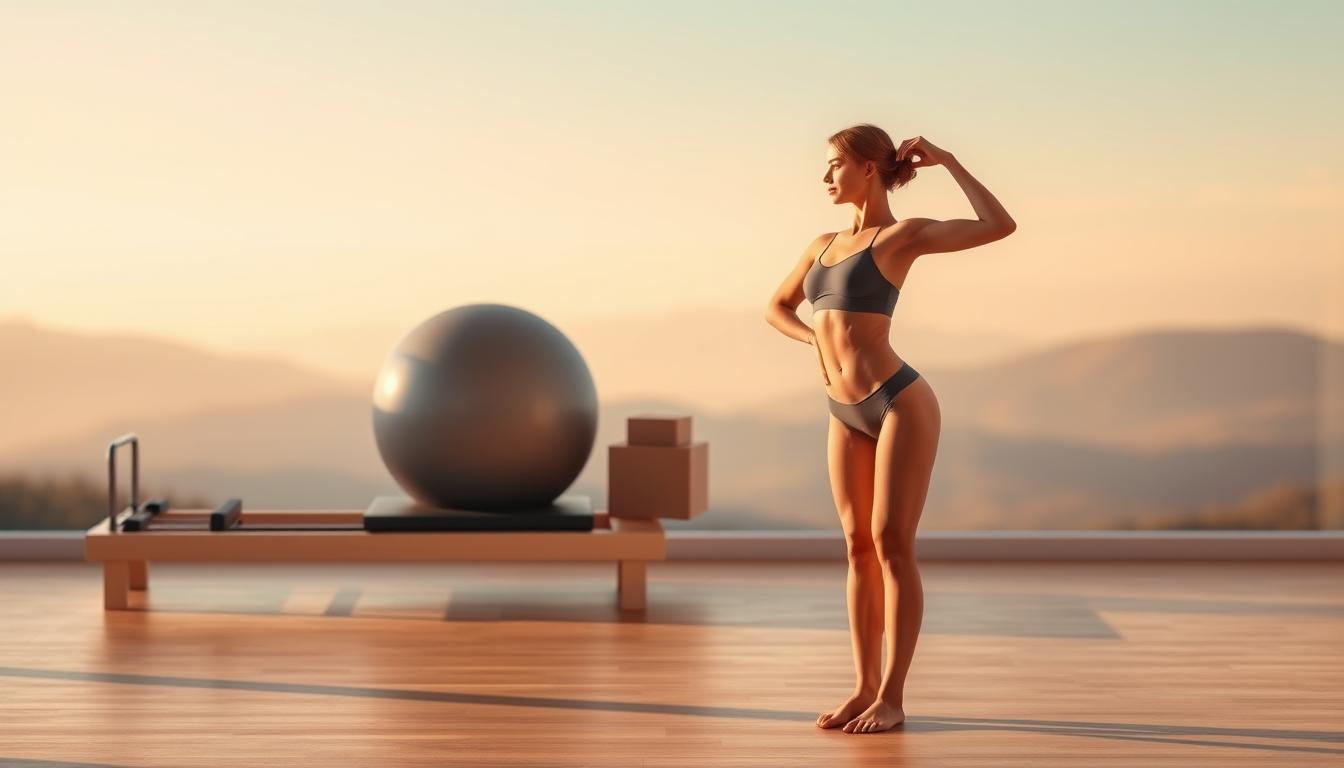Are you looking for a way to improve your overall fitness and transform your body? Look no further than Pilates, a low-impact exercise method that focuses on strengthening your core, improving flexibility, and enhancing balance.
By incorporating Pilates into your routine, you can experience a range of benefits that can enhance your overall well-being. This form of exercise is not just for athletes or fitness enthusiasts; it’s for anyone looking to improve their physical health and feel more confident in their own skin.
Key Takeaways
- Discover how Pilates can improve your strength and flexibility.
- Learn the basics of Pilates and how to get started.
- Understand the benefits of Pilates for overall health and wellness.
- Explore how Pilates can enhance your balance and coordination.
- Find out how to incorporate Pilates into your fitness routine.
What is Pilates and Its Core Principles
Pilates is a holistic exercise method that has gained popularity worldwide for its numerous physical and mental benefits. It is a low-impact, body-weight exercise discipline that focuses on strengthening the core, improving flexibility, and enhancing posture.
The History and Philosophy Behind Pilates
Pilates was developed in the early 20th century by Joseph Pilates, a German-born fitness enthusiast. Initially called “Contrology,” the method was designed to improve physical fitness, correct postural imbalances, and enhance overall well-being. Joseph Pilates believed that his method could help people achieve a balanced body and a strong, stable core.
The philosophy behind Pilates emphasizes the interconnectedness of the body’s movements and the importance of controlled, precise exercises. This approach encourages practitioners to engage their minds and bodies in the exercise process.
The Six Fundamental Principles of Pilates
The six fundamental principles of Pilates are:
- Centering: Engaging the core muscles to support the spine and maintain stability.
- Concentration: Focusing the mind on the exercise being performed.
- Control: Executing movements with precision and control.
- Precision: Performing exercises with accurate alignment and technique.
- Flow: Moving smoothly and fluidly between exercises.
- Breathing: Coordinating breathing with movement to enhance relaxation and focus.
How Pilates Differs from Other Exercise Methods
Pilates differs from other exercise methods in its focus on controlled, precise movements and its emphasis on core strength, flexibility, and body awareness. Unlike high-impact exercises, Pilates is a low-impact method that can be modified to suit different fitness levels and needs.
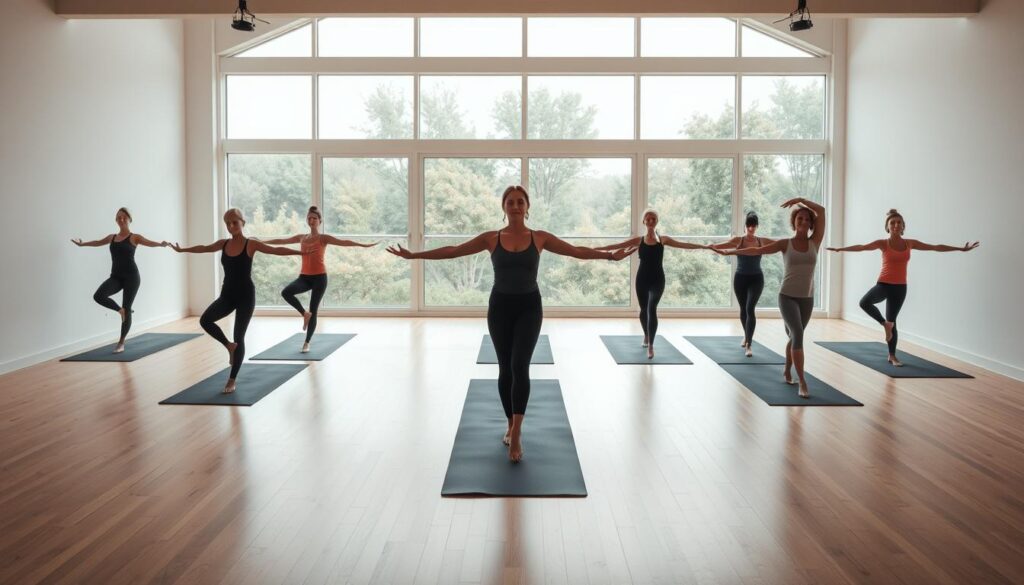
The Transformative Benefits of Pilates
Pilates offers a unique blend of physical movement and mental focus that can revolutionize your approach to fitness. By engaging in Pilates, individuals can experience a wide range of benefits that enhance both physical and mental well-being.
Building Core Strength and Stability
One of the primary benefits of Pilates is its ability to build core strength and stability. The core muscles, including the abdominals and back muscles, are essential for maintaining good posture, balance, and overall physical stability. Through targeted exercises, Pilates helps to strengthen these muscles, leading to improved overall physical fitness and reduced risk of injury. For Pilates for beginners, starting with core exercises can help establish a strong foundation for more advanced movements.
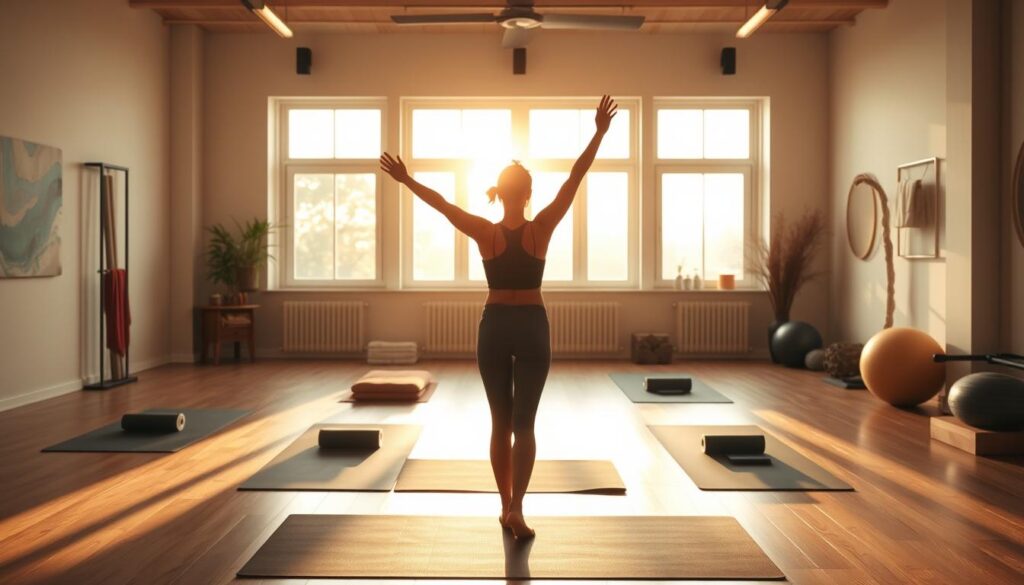
Enhancing Flexibility and Range of Motion
Pilates is also renowned for its ability to enhance flexibility and range of motion. By incorporating a variety of movements that stretch and lengthen the muscles, Pilates helps to improve flexibility, making it easier to perform daily activities and other exercises. Regular practice can lead to significant improvements in flexibility, contributing to overall physical fitness and well-being.
Improving Posture and Body Alignment
Another significant benefit of Pilates is its focus on improving posture and body alignment. By strengthening the core and improving flexibility, Pilates helps individuals maintain proper posture, reducing the risk of back pain and other musculoskeletal issues. Good posture also enhances overall physical appearance and confidence. Practicing Pilates at a pilates studio can provide personalized guidance on achieving proper alignment.
Mental Benefits: Focus, Stress Relief, and Mind-Body Connection
Beyond its physical benefits, Pilates offers numerous mental benefits, including improved focus, stress relief, and a deeper mind-body connection. The practice encourages mindfulness and concentration, helping to reduce stress and improve overall mental well-being. By fostering a stronger connection between the mind and body, Pilates enables individuals to become more aware of their movements and breathing, promoting a sense of calm and relaxation.
Essential Pilates Exercises for Total Body Transformation
Pilates is a holistic exercise method that encompasses a variety of movements designed to enhance strength, flexibility, and posture. By incorporating essential Pilates exercises into your routine, you can achieve a total body transformation that improves both physical and mental well-being.
Foundational Mat Exercises for Beginners
For those new to Pilates, starting with foundational mat exercises is crucial. These exercises lay the groundwork for more advanced movements and help build core strength, improve flexibility, and enhance body alignment.
The Hundred, Roll-Up, and Single Leg Circles
Beginners can start with exercises like The Hundred, which engages the core and promotes cardiovascular health, Roll-Up, which strengthens the abdominal muscles, and Single Leg Circles, which improves flexibility and control in the hips and legs.
Proper Form and Breathing Techniques
Maintaining proper form and utilizing breathing techniques are essential in Pilates. Proper form ensures that you are targeting the correct muscles, while breathing techniques help to engage your core and maintain control throughout each exercise.
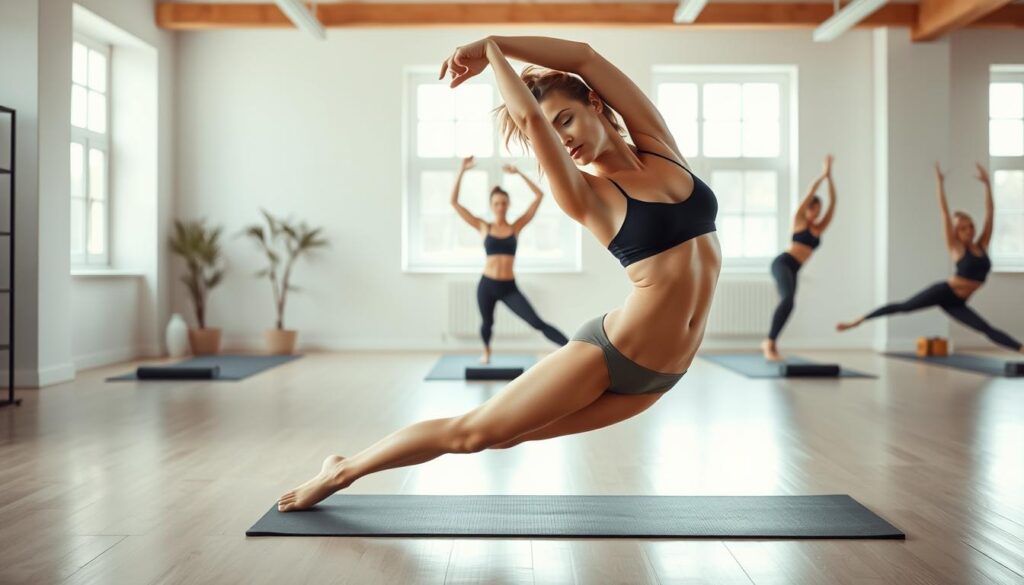
Intermediate Pilates Movements for Strength Building
Once you’ve mastered the foundational exercises, it’s time to progress to intermediate Pilates movements. These exercises are designed to build strength, enhance flexibility, and challenge your body in new ways.
Side Kicks, Plank Variations, and Spine Twist
Exercises like Side Kicks target the outer thighs and hips, Plank Variations engage the core and improve overall stability, and Spine Twist enhances spinal flexibility and rotation.
Progression Tips and Modifications
To continue making progress in your Pilates practice, it’s essential to understand how to modify exercises based on your fitness level. This might involve adjusting the intensity, range of motion, or incorporating props to make the exercises more accessible or challenging.
Advanced Exercises for Flexibility and Balance
For those who have progressed in their Pilates journey, advanced exercises offer a way to further challenge the body and achieve greater flexibility and balance.
Teaser, Control Balance, and Corkscrew
Advanced exercises such as Teaser, which challenges core strength and control, Control Balance, which demands balance and precision, and Corkscrew, which engages the core and promotes spinal flexibility, are excellent for pushing your practice to the next level.
Safely Advancing Your Practice
When advancing your Pilates practice, it’s crucial to do so safely. This involves listening to your body, avoiding overexertion, and working within your limits to prevent injury.
Creating Your Pilates Practice Routine
A well-planned Pilates routine can help you transform your body and improve overall well-being. To achieve this, it’s essential to create a practice schedule that suits your lifestyle and fitness goals.
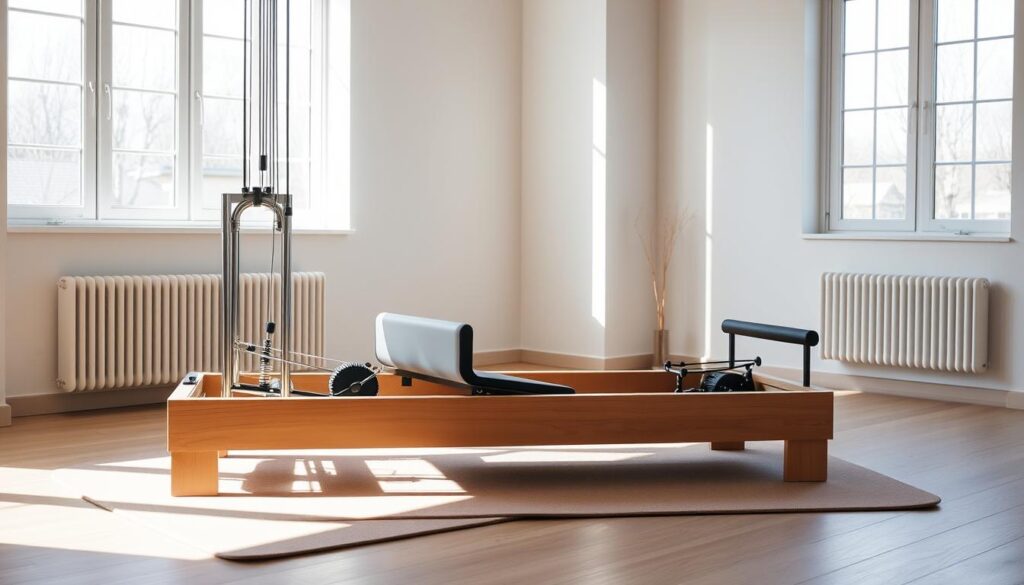
Determining the Ideal Frequency and Duration
The frequency and duration of your Pilates practice depend on your goals and current fitness level. For beginners, starting with 2-3 times a week is recommended, with each session lasting around 45-60 minutes. As you progress, you can increase the frequency and duration.
Combining Mat Work and Equipment Training
A well-rounded Pilates practice should include both mat work and equipment training. Mat exercises are great for building core strength and improving flexibility, while equipment like the Pilates Reformer can provide additional resistance and support. Many Pilates studios offer classes that combine both.
Sample Weekly Pilates Routines for Different Goals
Here are some sample weekly routines tailored to different goals:
- For strength and toning: Include exercises like the Hundred, Teaser, and Side Bends on the mat, and leg press and arm circles on the Pilates Reformer.
- For flexibility and relaxation: Focus on flowing movements and deep stretches, incorporating props like resistance bands and circles.
- For overall fitness: Combine mat exercises with equipment training, aiming for 3-4 sessions a week.
Tracking Your Progress and Adjusting Your Practice
Regularly tracking your progress is crucial to adjusting your Pilates practice. Keep a journal or use a fitness app to monitor your improvements and adjust your routine as needed. This will help you stay motivated and achieve your goals.
By following these guidelines and tailoring your Pilates practice to your needs, you can maximize the benefits of this powerful exercise method. Whether you’re practicing at home or in a Pilates studio, consistency and patience are key.
Navigating the World of Pilates Studios and Equipment
The world of Pilates is diverse, with various studios and equipment options catering to different needs and preferences. As you delve deeper into your Pilates practice, understanding the nuances of different studios and equipment can help you make informed decisions about your practice.
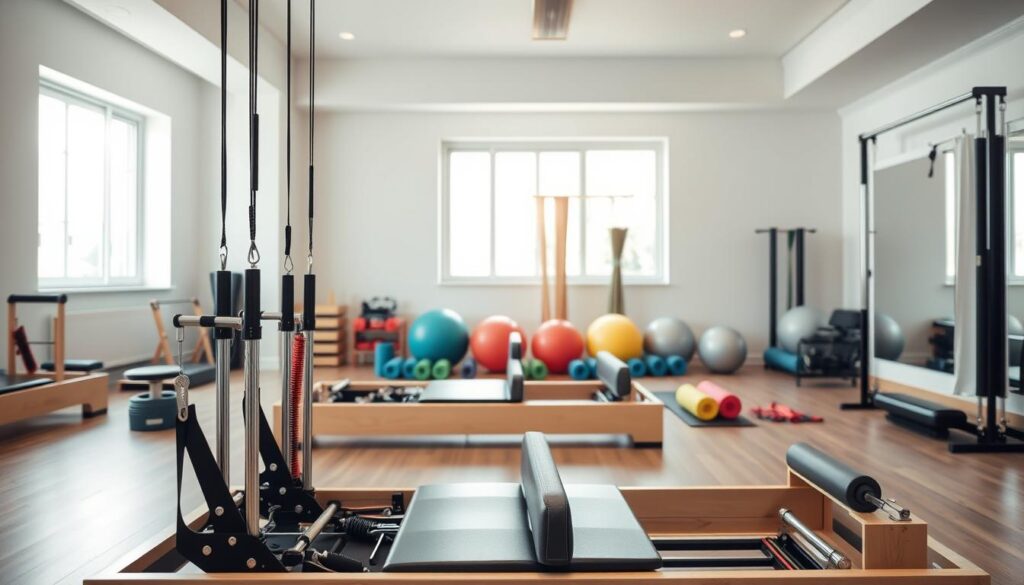
Choosing Between Mat Classes, Reformer, and Private Sessions
When it comes to Pilates classes, you have several options: mat classes, Reformer classes, and private sessions. Mat classes are great for beginners and focus on bodyweight exercises. Reformer classes utilize the Reformer machine, which provides resistance to help build strength and improve flexibility. Private sessions offer personalized attention and are ideal for those who need customized routines or have specific injuries.
- Mat classes: Ideal for beginners, group setting, and bodyweight exercises.
- Reformer classes: Utilizes the Reformer machine for added resistance and challenge.
- Private sessions: Personalized attention, customized routines, and injury rehabilitation.
Essential Home Equipment for Pilates Practitioners
While studios offer a variety of equipment, having some essential items at home can enhance your practice. Pilates mats are a must-have for comfort and hygiene. Other useful equipment includes resistance bands for added challenge and Pilates balls for engaging the core and improving balance.
Finding Qualified Instructors and Quality Studios
To get the most out of your Pilates practice, it’s crucial to find qualified instructors and quality studios. Look for studios with certified instructors who have a good reputation. Read reviews, ask for referrals, and observe a class before committing to ensure it’s the right fit for you.
By understanding your options and what to look for in a Pilates studio and equipment, you can enhance your Pilates journey and achieve your fitness goals.
Conclusion: Sustaining Your Pilates Journey for Long-Term Transformation
As you’ve discovered through this article, Pilates offers a holistic approach to fitness, enhancing strength, flexibility, and balance. To achieve long-term transformation, it’s essential to sustain your Pilates practice. By incorporating Pilates into your regular routine, you’ll continue to experience the numerous pilates benefits, from improved posture to reduced stress.
For those just starting out, pilates for beginners provides a foundation for a healthier, more balanced lifestyle. As you progress, you’ll find that Pilates becomes an integral part of your daily life, influencing your overall well-being and body awareness.
To maintain momentum, consider setting realistic goals and tracking your progress. This will help you stay motivated and committed to your Pilates journey. With consistent practice, you’ll not only achieve your fitness goals but also cultivate a deeper connection between your body and mind, reaping the full rewards of pilates.
FAQ
What is Pilates and how does it work?
Pilates is a physical fitness method that focuses on strengthening the core, improving flexibility, and enhancing posture and body alignment. It involves a range of exercises that engage the mind and body, promoting overall well-being.
What are the benefits of practicing Pilates?
The benefits of Pilates include improved core strength, enhanced flexibility, better posture, and reduced stress. It can also improve balance, coordination, and overall physical fitness, while promoting mental well-being.
What is the difference between mat Pilates and reformer Pilates?
Mat Pilates involves performing exercises on a mat on the floor, using body weight as resistance. Reformer Pilates, on the other hand, uses a specialized machine called a reformer, which provides additional resistance and support through springs and a moving carriage.
Do I need to have prior experience with Pilates to join a class?
No, you don’t need prior experience to join a Pilates class. Many Pilates studios offer classes for beginners, and instructors are trained to modify exercises to suit different fitness levels.
What should I wear to a Pilates class?
Wear comfortable, stretchy clothing that allows for a full range of motion. Avoid loose or baggy clothing that may get in the way of your movements.
Can Pilates help with back pain or injuries?
Yes, Pilates can be beneficial for people with back pain or injuries. It can help strengthen the core, improve posture, and promote gentle, controlled movements that can aid in recovery. However, it’s essential to consult with a healthcare professional or a qualified Pilates instructor before starting a new exercise program.
How often should I practice Pilates to see results?
The frequency of Pilates practice depends on your goals and fitness level. For most people, practicing Pilates 2-3 times per week can lead to noticeable improvements in strength, flexibility, and overall fitness.
Can I do Pilates at home, or do I need to join a studio?
You can practice Pilates at home using online resources, DVDs, or by investing in a Pilates reformer or other equipment. However, joining a studio can provide access to qualified instructors, a supportive community, and a more varied workout experience.
